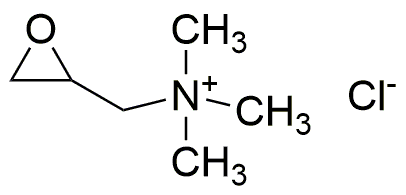Glycidyltrimethylammonium chloride is widely utilized in research focused on:
- Polymer Chemistry: It serves as a key monomer for synthesizing cationic polymers, which are used in coatings, adhesives, and sealants, enhancing their performance and durability.
- Biotechnology: This compound is employed in the modification of biomolecules, allowing for improved drug delivery systems and targeted therapies in pharmaceuticals.
- Surface Modification: It is used to modify surfaces of materials to improve adhesion properties, making it valuable in industries like electronics and automotive for better performance of components.
- Textile Industry: The chemical is applied in creating functional textiles with antimicrobial properties, providing added value in clothing and medical textiles.
- Water Treatment: Glycidyltrimethylammonium chloride is effective in the formulation of flocculants and coagulants, aiding in the purification of water and wastewater treatment processes.
General Information
Properties
Safety and Regulations
Applications
Glycidyltrimethylammonium chloride is widely utilized in research focused on:
- Polymer Chemistry: It serves as a key monomer for synthesizing cationic polymers, which are used in coatings, adhesives, and sealants, enhancing their performance and durability.
- Biotechnology: This compound is employed in the modification of biomolecules, allowing for improved drug delivery systems and targeted therapies in pharmaceuticals.
- Surface Modification: It is used to modify surfaces of materials to improve adhesion properties, making it valuable in industries like electronics and automotive for better performance of components.
- Textile Industry: The chemical is applied in creating functional textiles with antimicrobial properties, providing added value in clothing and medical textiles.
- Water Treatment: Glycidyltrimethylammonium chloride is effective in the formulation of flocculants and coagulants, aiding in the purification of water and wastewater treatment processes.
Documents
Safety Data Sheets (SDS)
The SDS provides comprehensive safety information on handling, storage, and disposal of the product.
Product Specification (PS)
The PS provides a comprehensive breakdown of the product’s properties, including chemical composition, physical state, purity, and storage requirements. It also details acceptable quality ranges and the product's intended applications.
Certificates of Analysis (COA)
Search for Certificates of Analysis (COA) by entering the products Lot Number. Lot and Batch Numbers can be found on a product’s label following the words ‘Lot’ or ‘Batch’.
Número de catálogo
Número de lote/lote
Certificates Of Origin (COO)
This COO confirms the country where the product was manufactured, and also details the materials and components used in it and whether it is derived from natural, synthetic, or other specific sources. This certificate may be required for customs, trade, and regulatory compliance.
Número de catálogo
Número de lote/lote
Safety Data Sheets (SDS)
The SDS provides comprehensive safety information on handling, storage, and disposal of the product.
DownloadProduct Specification (PS)
The PS provides a comprehensive breakdown of the product’s properties, including chemical composition, physical state, purity, and storage requirements. It also details acceptable quality ranges and the product's intended applications.
DownloadCertificates of Analysis (COA)
Search for Certificates of Analysis (COA) by entering the products Lot Number. Lot and Batch Numbers can be found on a product’s label following the words ‘Lot’ or ‘Batch’.
Número de catálogo
Número de lote/lote
Certificates Of Origin (COO)
This COO confirms the country where the product was manufactured, and also details the materials and components used in it and whether it is derived from natural, synthetic, or other specific sources. This certificate may be required for customs, trade, and regulatory compliance.


